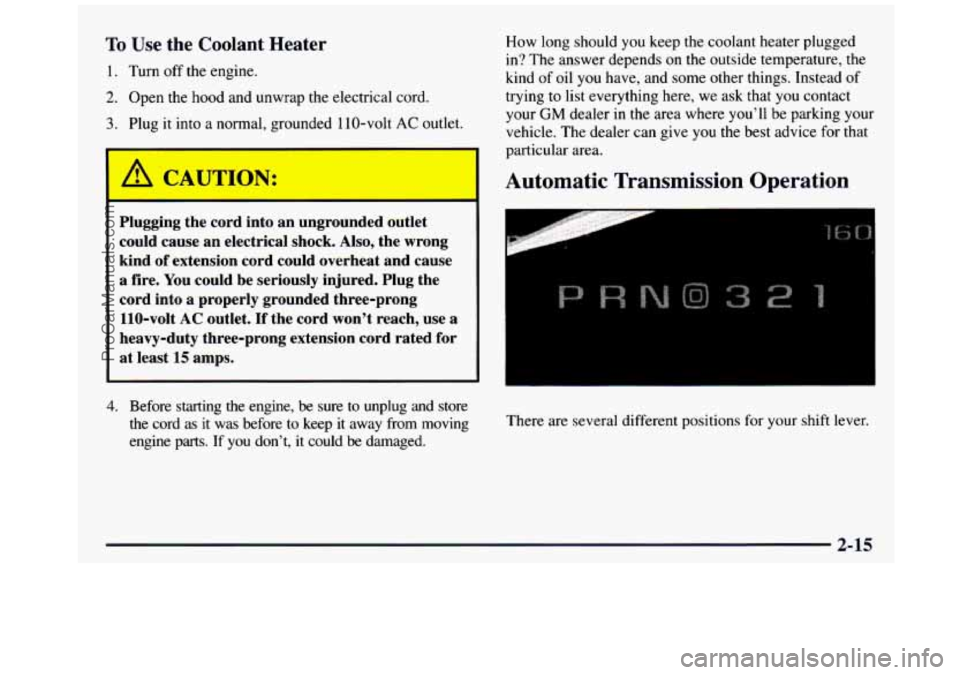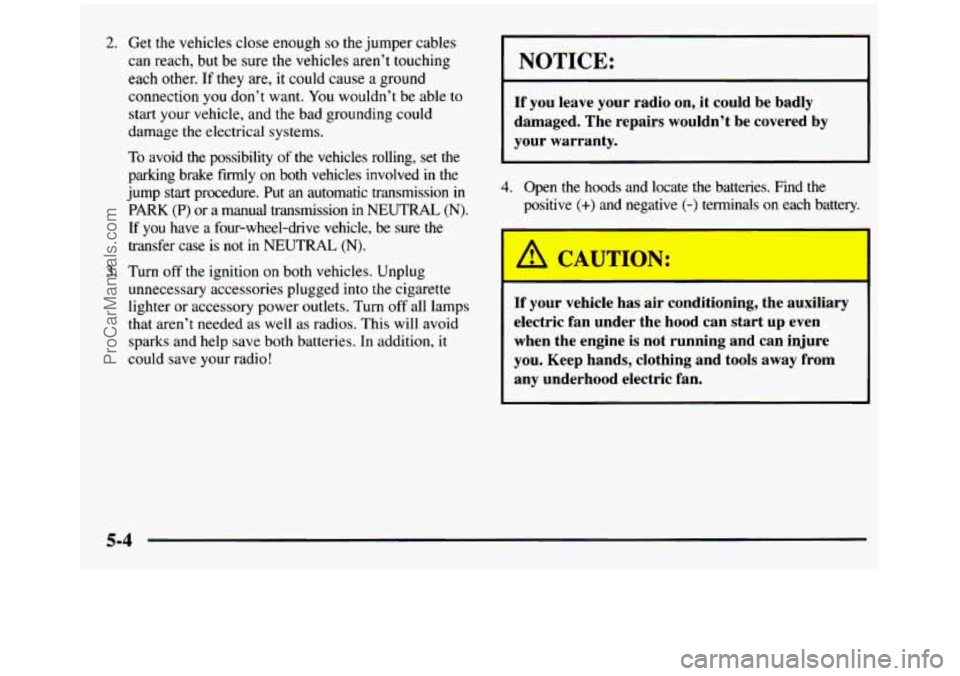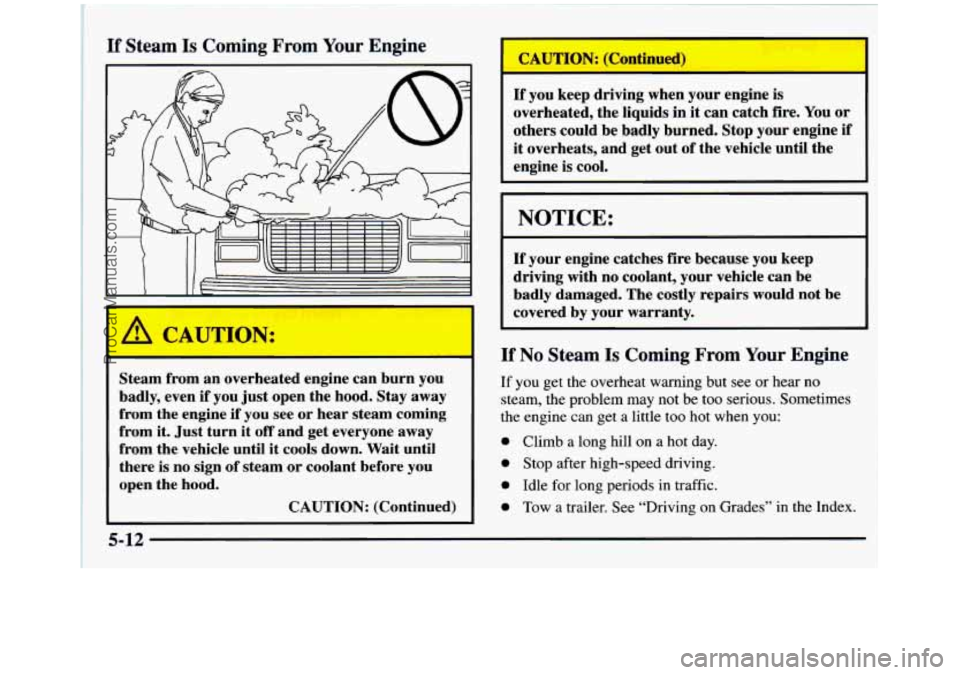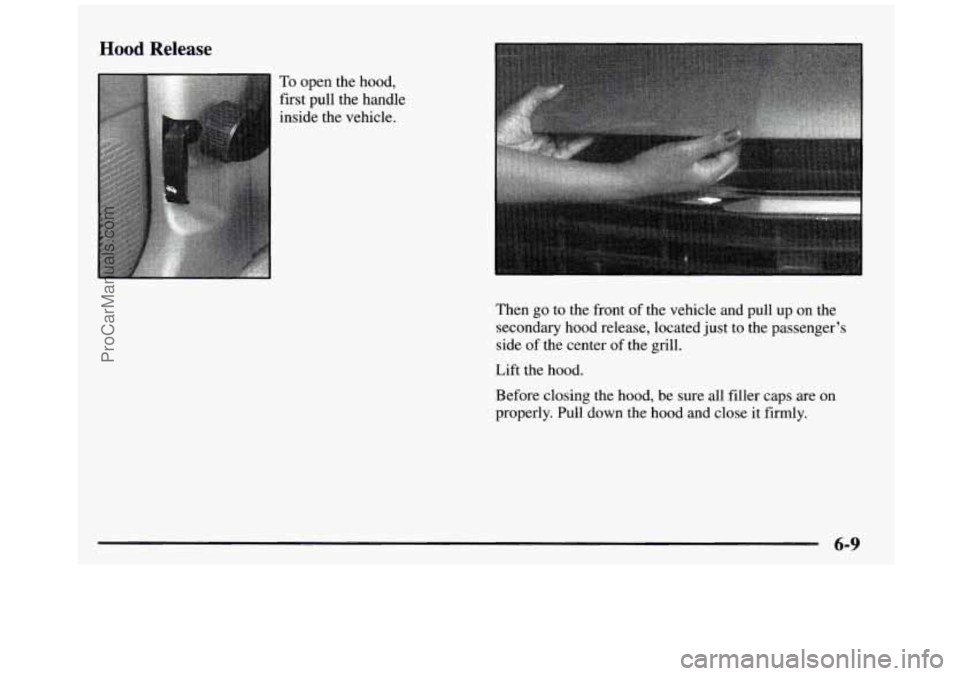1997 GMC SIERRA open hood
[x] Cancel search: open hoodPage 89 of 436

To Use the Coolant Heater
1. Turn off the engine.
2. Open the hood and unwrap the electrical cord,
3. Plug it into a normal, grounded 110-volt AC outlet.
I
I
Plugging the cord into an ungrounded outlet
could cause an electrical shock. Also, the wrong
kind
of extension cord could overheat and cause
a fire. You could be seriously injured. Plug the
cord into a properly grounded three-prong
110-volt
AC outlet. If the cord won’t reach, use a
heavy-duty three-prong extension cord rated for
at least
15 amps.
How long should you keep the coolant heater plugged
in? The answer depends
on the outside temperature, the
kind of oil you have, and some other things. Instead
of
trying to list everything here, we ask that you contact
your
GM dealer in the area where you’ll be parking your
vehicle. The dealer can give you the best advice
for that
particular area.
Automatic Transmission Operation
4. Before starting the engine, be sure to unplug and store
the cord as
it was before to keep it away from moving
engine
parts. If you don’t, it could be damaged. There are
several different positions for your shift lever.
ProCarManuals.com
Page 244 of 436

2. Get the vehicles close enough so the jumper cables
can reach, but be
sure the vehicles aren’t touching
each other. If they are, it could cause a ground connection you don’t want. You wouldn’t be able to
start your vehicle, and the bad grounding could
damage the electrical systems.
To avoid the possibility of the vehicles rolling, set the
parking brake
fmly on both vehicles involved in the
jump stat procedure. Put an automatic transmission in
PARK (P) or a manual transmission in NEUTRAL (N).
If you have a four-wheel-drive vehicle, be sure the
transfer case is not
in NEUTRAL (N).
3. Turn off the ignition on both vehicles. Unplug
unnecessary accessories plugged into the cigarette
lighter or accessory power outlets. Turn
off all lamps
that aren’t needed as well
as radios. This will avoid
sparks and help save both batteries.
In addition, it
could save your radio!
I NOTICE:
If you leave your radio on, it could be badly
damaged. The repairs wouldn’t be covered by
your warranty.
4. Open the hoods and locate the batteries. Find the
positive
(+) and negative (-) terminals on each battery.
If your vehicle has air conditioning, the auxiliary
electric fan under the hood can start
up even
when the engine is not running and can injure
you. Keep hands, clothing and tools away
from
any underhood electric fan.
5-4
ProCarManuals.com
Page 252 of 436

I
If Steam Is Coming From Your Engine
I A CAUTION:
Steam from an overheated engine can burn you
badly, even if you just open the hood. Stay away
from the engine
if you see or hear steam coming
from it. Just turn it
off and get everyone away
from the vehicle until it cools down. Wait until
there is no sign of steam or coolant before you
open the hood.
CAUTION: (Continued) tin
If you
keep driving when your engine is
overheated, the liquids in it can catch fire. You or
others could be badly burned. Stop your engine if
it overheats, and get out of the vehicle until the
engine is cool.
I NOTICE:
If your engine catches fire because you keep
driving with no coolant, your vehicle can be
badly damaged. The costly repairs would not be
covered by your warranty.
If No Steam Is Coming From Your Engine
If you get the overheat warning but see or hear no
steam, the problem may not be
too serious. Sometimes
the engine can get a little too hot when
you:
0 Climb a long hill on a hot day.
0 Stop after high-speed driving.
0 Idle for long periods in traffic.
0 Tow a trailer. See “Driving on Grades” in the Index.
ProCarManuals.com
Page 253 of 436

If you get the overheat warning with no sign of steam,
try this for a minute or
so:
1. If you have an air conditioner, turn it off.
2. Turn on your heater to full hot at the highest fan
speed and open the window
as necessary.
3. If you’re in a traffic jam, shift to NEUTRAL (N);
otherwise, shift to the highest gear while
driving
-- AUTOMATIC OVERDRIVE (@)
for automatic transmissions.
If you no longer have
the overheat warning, you can
drive. Just
to be safe, drive slower for about 10 minutes.
If the warning doesn’t come back
on, you can
drive normally.
If the warning continues, pull over, stop, and park your
vehicle right away.
If there’s still no sign of steam, push the accelerator until
the engine speed is about twice as fast as normal idle
speed. Bring the engine speed back to normal idle speed
after two or three minutes. Now see if the warning stops.
But then, if
you still have the warning, turn oflthe
engine and get everyone out
of the vehicle until it
cools down.
Cooling System -- Gasoline Engines
When you decide it’s safe to lift the hood, here’s what
you’ll see:
A. Coolant Recovery Tank
B. Radiator Pressure Cap
C. Engine Fan(s)
You may decide
not to lift the hood but to get service
help right away.
ProCarManuals.com
Page 285 of 436

Hood Release
To open the hood,
first pull the handle
inside the vehicle.
Then
go to the front of the vehicle and pull up on the
secondary hood release, located just to the passenger’s
side of the center
of the grill.
Lift the hood.
Before closing the hood, be sure all filler caps are on
properly. Pull down the hood and close it firmly.
6-9
ProCarManuals.com
Page 427 of 436

Garage Door Opener ............................ 2-52
GAWR
....................................... 4-41
Gear Positions. Automatic Transmission
............. 2- 15
Gear Positions. Manual Transmission .......... 2- 19. 2-20
GloveBox
.................................... 2-52
Gross Axle Weight Rating
........................ 4-41
Gross Vehicle Weight Rating ...................... 4-41
Guide
en Fransais 11
GVWR ....................................... 4-41
.. .................................
Halogen Bulbs ................................ 6-39
Hazard Warning Flashers
.......................... 5-2
Head Restraints
................................. 1-6
Headlamps .................................... 2-43
Bulb Replacement
....................... 6.40. 6.41
HigWLow Beam Changer
...................... 2-37
OnReminder
................................ 2-44
Wiring
..................................... 6-70
Hearing Impaired. Customer Assistance
.............. 8-4
Heating
........................................ 3-4
High-Beam Headlamps
.......................... 2-37
Highway Hypnosis
.............................. 4-35
Hill and Mountain Roads
......................... 4-35
Hitches. Trailer
................................. 4-53
Hood Checking Things Under
......................... 6-8
Release
...................................... 6-9
Hydraulic Clutch Fluid
........................... 6-26
Hydroplaning
.................................. 4-3 1
Horn
......................................... 2-35 Ignition
Positions
.............................. 2-11
Ignition Transmission Lock Check
................. 7-48
Illuminated Entry
............................... 2-46
Inflation. Tire
.................................. 6-51
Inside Daymight Rearview Mirror
................. 2-48
Inspections
.................................... 7-49
Brake System
................................ 7-50
DriveAxle
.................................. 7-50
Exhaust Systems
............................. 7-49
Radiator and Heater Hose
...................... 7-49
Steering
.................................... 7-49
Suspension
.................................. 7-49
Throttle Linkage
.............................. 7-49
Transfer Case (Four-wheel Drive)
............... 7-50
Instrumentpanel
............................... 2-62
Cleaning
.................................... 6-63
Cluster
..................................... 2-64
FuseBlock
.................................. 6-71
Intensity Control
............................. 2-46
Interior Lamps
................................. 2-46
.................................... J ack. Tire 5-23
Jump Starting
................................... 5-3
Key Lock Cylinders Service
..................... 7-46
Key Release Button
............................. 2-12
Keyless Entry System
............................ 2-7
Keys
.......................................... 2-2
9-5
ProCarManuals.com